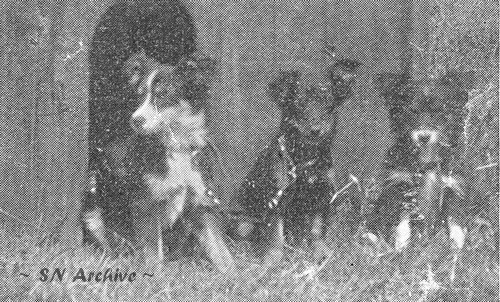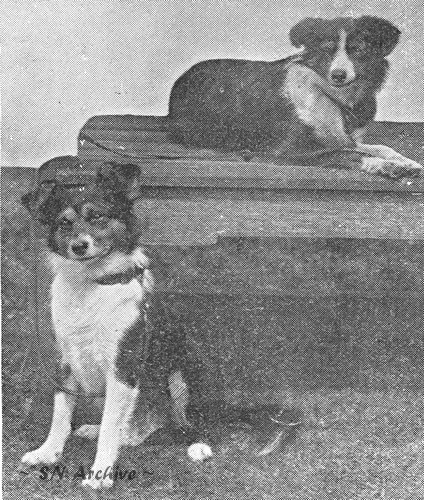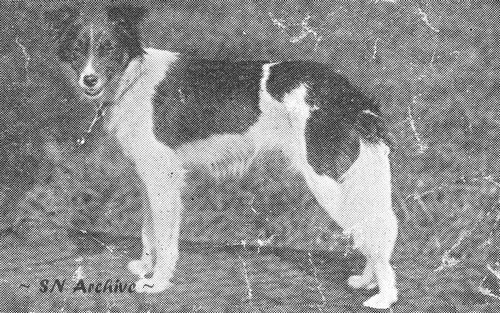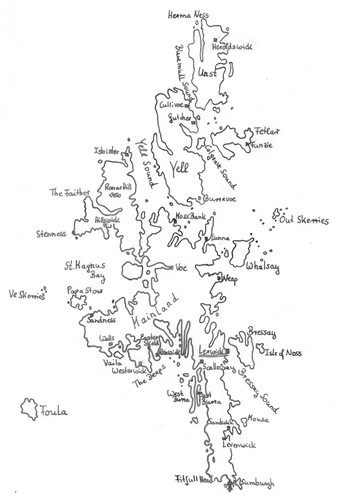| To the Gentlewoman who LOVES her DOG Notes and Comments about the Shetland sheepdog The Shetland Sheepdog - Miss Beryl Thynne's Kennel Of Shetland Sheepdogs |
|
The Gentlewoman, 18.04, 1914, Page 534 & 535:
"The Shetland sheepdog is getting more and more into the limelight, and it is on the cards that before many years have passed he will have grown into goodly numbers. At the annual meeting of the Scottish Shetland Sheepdog Club the other day a revision of Rule 15 was made to which attention may well be called. The old rule read, 'The general appearance of the Scottish Shetland sheepdog is that of an oridnary collie in miniature. In height about 12 in., and weight from 10 to 14 lb.' Revised it runs, 'The general appearance of the Shetland sheepdog is that of the modern show collie in miniature. Ideal height, 12 ins. at maturity, which is fixed at ten months old.' It was further decided that a borsoi-like head is undesirable.
Before long we may expect to see a distinct improvement in type. Already the rounded skull is becoming rarer, and in every respect the midgets are more closely approximating to the stamp of their larger brethren. If we can ultimately get a replica of the real collie in minature we shall indeed have a charming little creature. In their homeland they pass under the name of Peerie collies, this being the term for 'small', and those who have met them there speak highly of their dispositions and looks. Lively and merry as companions, with plenty of activity, and the desire to protect their master's property, they have many of the qualities which all of us wish to find in our canine friends.
I believe the Shetland has been ransacked pretty thoroughly by visitors in search of a marketable commoditiy, and it is possible that a few undesirable ones may have been foisted upon too eager purchasers, who either had no judgement or feared to exercise it. I understand the secretary of the Shetland Collie Club, Lerwick (Mr. James A. Loggie), has kept a register in which particulars are entered of dogs that conform to the club standard. This is an excellent idea, that deserves the gratitude of all who got to the fountain head for their stock.
The days slip by with so much rapidity that it is incredible to think nearly six years have passed since THE GENTLEWOMAN published a photograph of one of these midgets, when the knowledge of them was entirely visionary. The original of this picture was so diminutive that he scaled but 9 lbs., and his chief occupation seemed to be rounding up the hens when they strayed into an unautorised part of the property.
In the days of my boyhood I can rember an old shepherd employed by my father having a bitch that could not have been very much higher than one of the Shetland dogs, but she was thoroughly typical, with a fine head, nicely carried ear, and splendid coat. From whose strain she came I cannot say, but her master always declared that she was of the best. She was certainly a delightful little bitch of whom we were all very fond."
We have found an article in 1908-The Gentlewoman, which mentioned the Shetland Collie Olafsen, perhaps this is the dog the writer here refered to?
The Gentlewoman, 10.10.1914, Page 298:
In this one page article there are 4 photos of Kilravock Shelties. I can only show three here. The 4th photo of Caliph Of Kilravock is unfortunately only a black spot in my excerpt.
"THE SHETLAND SHEEPDOG.
THIS dog is indigenous to Shetland, from whence it derives its name. It is a distinct breed, and was originally known as the Shetland collie or Toonie dog, the latter title from its being used to drive sheep off the township, croft, or 'Toon'. It is believed to have descended from the Scotch collie, its diminutive size being due to inbreeding, and probably the hard conditions of existence in Shetland. In more recent years the breed has been crossed with what is known as the 'Yakki' dog, which had been left by whalers frequenting the island from Greenland. The present day Shetland sheepdog is very hard, affectionate, and faithful, a lover of children, and never treacherous. On its native heath it is used by the crofter to drive the sheep back to the hills from which they come down to feed off the stacks of hay and corn, and the turnips and cabbages in the arable land. In colour they are black and tan, black and white, black tan and white, black, sable, and sable and white. Mr. Theo. Marples, in his excellent book on show dogs, gives the following standard of points or general description of the breed: ..." [see our book snippet 1907-1932-Show Dogs]
The Kennel Club recognised the breed in 1909, and so recently as last August, on the joint application of the Old English Sheepdog Club [editor note: Error devil? Shouldn't it be Scottish Sheepdog Club? What has the Bobtail Club got to do with it?] and the Shetland Sheepdog Club, the Kennel Club General Committee decided to provide a separate classification on the register for Shetland sheepdogs. The Scottish Sheepdog Club, the Shetland Sheepdog Club, and the English Shetland Sheepdog Club have been formed to look after the interests of the breed, the total membership approximting 200, which is evidence that the breed is increasing in popularity, and with careful breeding on scientific lines, an improved and fixed type must soon result."



"MISS BERYL THYNNE'S OF SHETLAND SHEEP DOGS.
One of the most enthusiastic fanciers of Shetland sheepdogs is the lady whose kennel is this week reviewed and illustrated. Miss Thynne became enamoured with the breed at Olympia Show, 1913, shortly afterwards purchasing Kilravock Laddie from Mr. C. F. Thompson of Inverness, and ultimately increasing her kennel by purchasing several others. The Kilravock kennels are situated at 'The Paddock,' Newtown, Newbury, Berks; and among the inmates may be mentioned Kilravock Laddie, a nice tricolour dog, born May 26th, 1911, by Inverness Yarrow ex Inverness Topsy, bred by Mr. C. F. Thompson, as above stated. This dog has won First, Limit Class, Olympia; First Open Class, Kennel Club; Third, Open Class, L.K.A. (members); Second, Limit Class, Pet Dog Show; and many specials.
Kilravock Eureka, a tricolour bitch, born February 13th, 1913. Breeder, Mr. R. Williamson. Sire, Prince; dam, Fanny. A winner of First, Puppy; Second, Novice; Second, Graduate; Second, Special Limit; Second, Limit; Second, Open Classes; and five specials, at Aberdeen Show. First, Puppy; Third, Limit; Third, Open Classes, Birmingham Show. Also a winner at Tunbridge Wells, Taunton, L.K.A., Richmond, Newbury, and Eastbourne, with many special prizes.
Kilravock Spriggie, a tricolour dog. Born March 13th, 1912. Sire, Prince; dam, Fanny II. Breeder, Mrs. Cavin. A winner at Newbury, Eastbourne, and other shows.
Caliph of Kilravock, a tricolour dog. Born November 7th, 1913. Sire, Kilravock Spriggie; dam, Daisy II. Breeder, Mr. A. Henderson. Winner of Third Prize, Richmond.
Cleopatra of Kilravock, a black-and-white bitch, by Sir Jock; dam, Queen. Born July 20th, 1913. Breeder, Mrs. Kennedy. Very promising, a coming champion."
If you discover any errors in the text that may have been caused by the transcription, please let us know for a prompt correction.

